In this chapter, we will modify the previously introduced HTTP Client&Server example to a GRPC microservice and demonstrate how to develop a simple GRPC server and client using the GoFrame framework and add tracing features to the GRPC microservice.
The example code for this chapter is located at: https://github.com/gogf/gf/tree/master/example/trace/grpc_with_db
Directory Structure
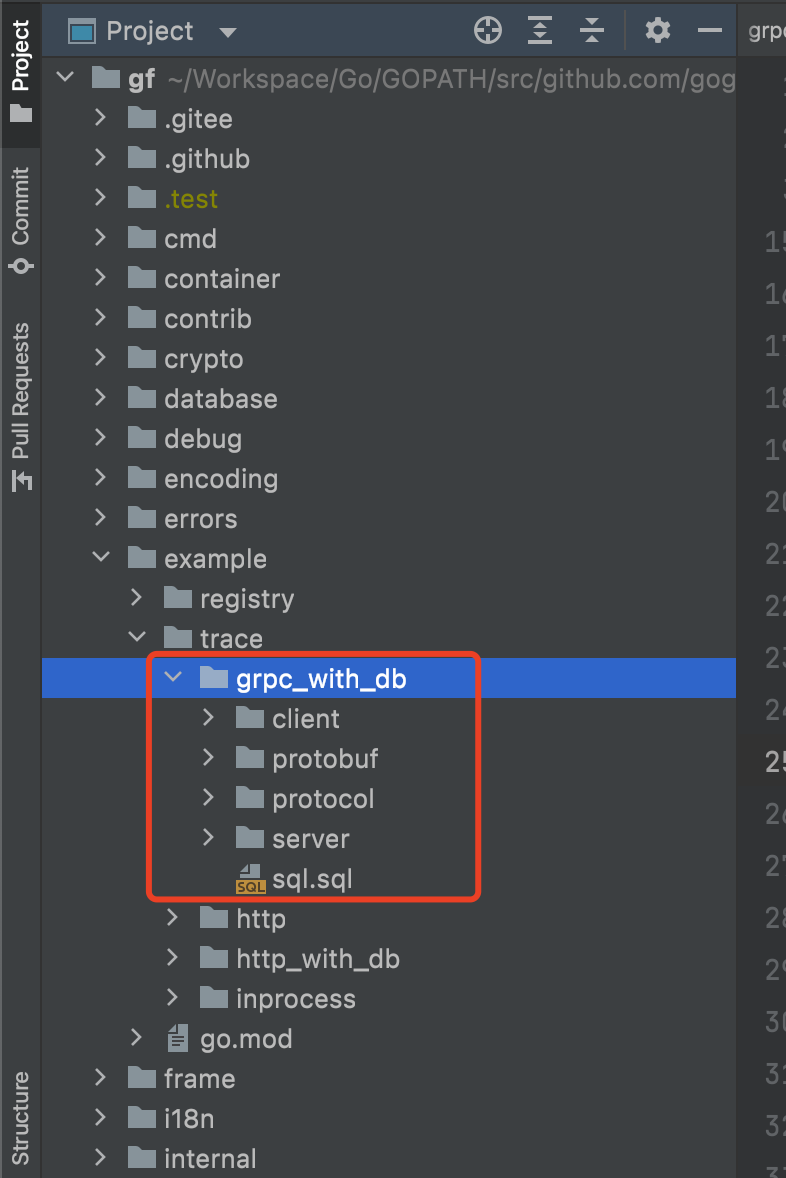
Protobuf
syntax = "proto3";
package user;
option go_package = "protobuf/user";
// User service for tracing demo.
service User {
rpc Insert(InsertReq) returns (InsertRes) {}
rpc Query(QueryReq) returns (QueryRes) {}
rpc Delete(DeleteReq) returns (DeleteRes) {}
}
message InsertReq {
string Name = 1; // v: required#Please input user name.
}
message InsertRes {
int32 Id = 1;
}
message QueryReq {
int32 Id = 1; // v: min:1#User id is required for querying.
}
message QueryRes {
int32 Id = 1;
string Name = 2;
}
message DeleteReq {
int32 Id = 1; // v:min:1#User id is required for deleting.
}
message DeleteRes {}
Use the gf gen pb command to compile this proto file, which will generate the corresponding grpc interface and data structure files.
GRPC Server
package main
import (
_ "github.com/gogf/gf/contrib/drivers/mysql/v2"
_ "github.com/gogf/gf/contrib/nosql/redis/v2"
"github.com/gogf/gf/contrib/registry/etcd/v2"
"github.com/gogf/gf/example/trace/grpc_with_db/protobuf/user"
"context"
"fmt"
"time"
"github.com/gogf/gf/contrib/rpc/grpcx/v2"
"github.com/gogf/gf/contrib/trace/otlpgrpc/v2"
"github.com/gogf/gf/v2/database/gdb"
"github.com/gogf/gf/v2/frame/g"
"github.com/gogf/gf/v2/os/gcache"
"github.com/gogf/gf/v2/os/gctx"
)
type Controller struct {
user.UnimplementedUserServer
}
const (
serviceName = "otlp-grpc-server"
endpoint = "tracing-analysis-dc-bj.aliyuncs.com:8090"
traceToken = "******_******"
)
func main() {
grpcx.Resolver.Register(etcd.New("127.0.0.1:2379"))
var ctx = gctx.New()
shutdown, err := otlpgrpc.Init(serviceName, endpoint, traceToken)
if err != nil {
g.Log().Fatal(ctx, err)
}
defer shutdown()
// Set ORM cache adapter with redis.
g.DB().GetCache().SetAdapter(gcache.NewAdapterRedis(g.Redis()))
s := grpcx.Server.New()
user.RegisterUserServer(s.Server, &Controller{})
s.Run()
}
// Insert is a route handler for inserting user info into database.
func (s *Controller) Insert(ctx context.Context, req *user.InsertReq) (res *user.InsertRes, err error) {
result, err := g.Model("user").Ctx(ctx).Insert(g.Map{
"name": req.Name,
})
if err != nil {
return nil, err
}
id, _ := result.LastInsertId()
res = &user.InsertRes{
Id: int32(id),
}
return
}
// Query is a route handler for querying user info. It firstly retrieves the info from redis,
// if there's nothing in the redis, it then does db select.
func (s *Controller) Query(ctx context.Context, req *user.QueryReq) (res *user.QueryRes, err error) {
err = g.Model("user").Ctx(ctx).Cache(gdb.CacheOption{
Duration: 5 * time.Second,
Name: s.userCacheKey(req.Id),
Force: false,
}).WherePri(req.Id).Scan(&res)
if err != nil {
return nil, err
}
return
}
// Delete is a route handler for deleting specified user info.
func (s *Controller) Delete(ctx context.Context, req *user.DeleteReq) (res *user.DeleteRes, err error) {
err = g.Model("user").Ctx(ctx).Cache(gdb.CacheOption{
Duration: -1,
Name: s.userCacheKey(req.Id),
Force: false,
}).WherePri(req.Id).Scan(&res)
return
}
func (s *Controller) userCacheKey(id int32) string {
return fmt.Sprintf(`userInfo:%d`, id)
}
Brief explanation of the server code:
-
First, the server needs to initialize
Jaegerthrough thejaeger.Initmethod. -
As you can see, the business logic is entirely consistent with the previous HTTP example project, only the access layer is modified for the GRPC protocol.
-
We still inject Redis cache via the cache adapter:
g.DB().GetCache().SetAdapter(gcache.NewAdapterRedis(g.Redis()))
- Here, we also enable the cache feature of
ORMusing theCachemethod, which has already been introduced before and will not be elaborated on here.
GRPC Client
package main
import (
"github.com/gogf/gf/contrib/registry/etcd/v2"
"github.com/gogf/gf/contrib/rpc/grpcx/v2"
"github.com/gogf/gf/contrib/trace/otlpgrpc/v2"
"github.com/gogf/gf/example/trace/grpc_with_db/protobuf/user"
"github.com/gogf/gf/v2/frame/g"
"github.com/gogf/gf/v2/net/gtrace"
"github.com/gogf/gf/v2/os/gctx"
)
const (
serviceName = "otlp-grpc-client"
endpoint = "tracing-analysis-dc-bj.aliyuncs.com:8090"
traceToken = "******_******"
)
func main() {
grpcx.Resolver.Register(etcd.New("127.0.0.1:2379"))
var ctx = gctx.New()
shutdown, err := otlpgrpc.Init(serviceName, endpoint, traceToken)
if err != nil {
g.Log().Fatal(ctx, err)
}
defer shutdown()
StartRequests()
}
func StartRequests() {
ctx, span := gtrace.NewSpan(gctx.New(), "StartRequests")
defer span.End()
client := user.NewUserClient(grpcx.Client.MustNewGrpcClientConn("demo"))
// Baggage.
ctx = gtrace.SetBaggageValue(ctx, "uid", 100)
// Insert.
insertRes, err := client.Insert(ctx, &user.InsertReq{
Name: "john",
})
if err != nil {
g.Log().Fatalf(ctx, `%+v`, err)
}
g.Log().Info(ctx, "insert id:", insertRes.Id)
// Query.
queryRes, err := client.Query(ctx, &user.QueryReq{
Id: insertRes.Id,
})
if err != nil {
g.Log().Errorf(ctx, `%+v`, err)
return
}
g.Log().Info(ctx, "query result:", queryRes)
// Delete.
_, err = client.Delete(ctx, &user.DeleteReq{
Id: insertRes.Id,
})
if err != nil {
g.Log().Errorf(ctx, `%+v`, err)
return
}
g.Log().Info(ctx, "delete id:", insertRes.Id)
// Delete with error.
_, err = client.Delete(ctx, &user.DeleteReq{
Id: -1,
})
if err != nil {
g.Log().Errorf(ctx, `%+v`, err)
return
}
g.Log().Info(ctx, "delete id:", -1)
}
Brief explanation of the client code:
-
First, the client also needs to initialize
Jaegerthrough thejaeger.Initmethod. -
The client is very simple, internal initialization and setting of default interceptors have been encapsulated by the
Katyushaframework, developers need only focus on implementing business logic.
Effect Viewing
Start the Server:

Start the Client:
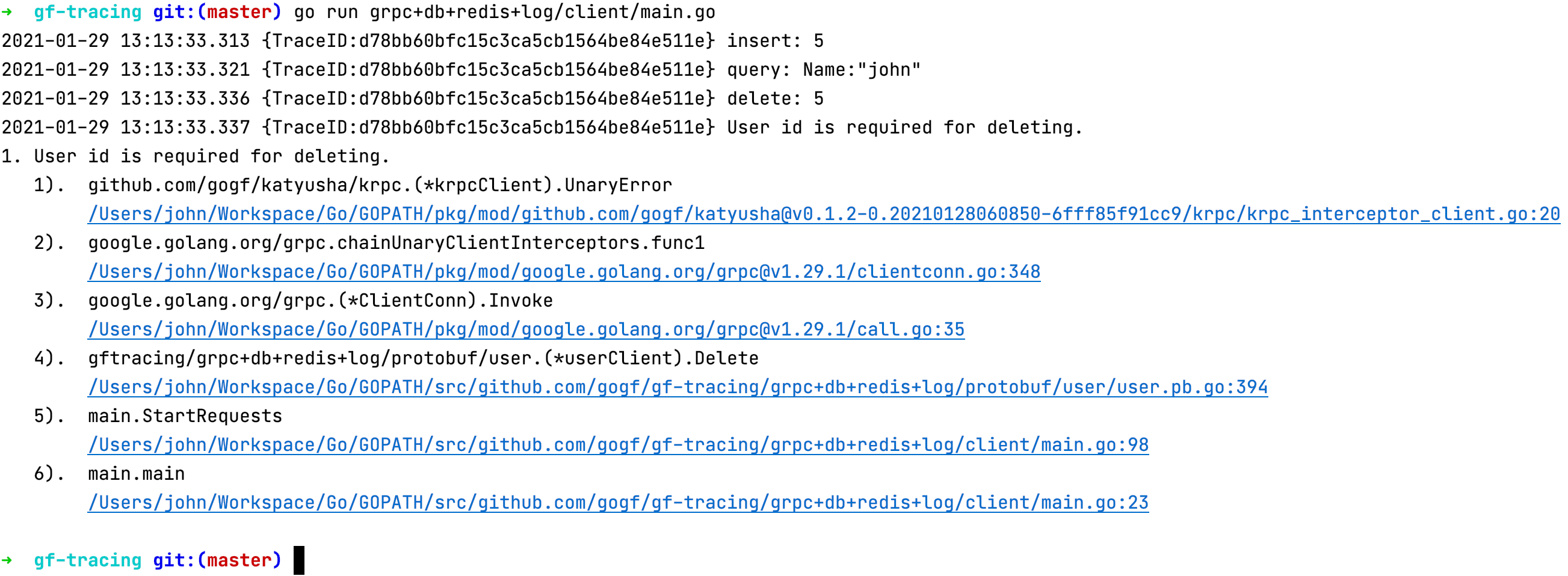
At the end of the client execution here, an error was reported, which we did intentionally, to demonstrate the link information display when GRPC has an error. Let's open jaeger to check the tracing information:
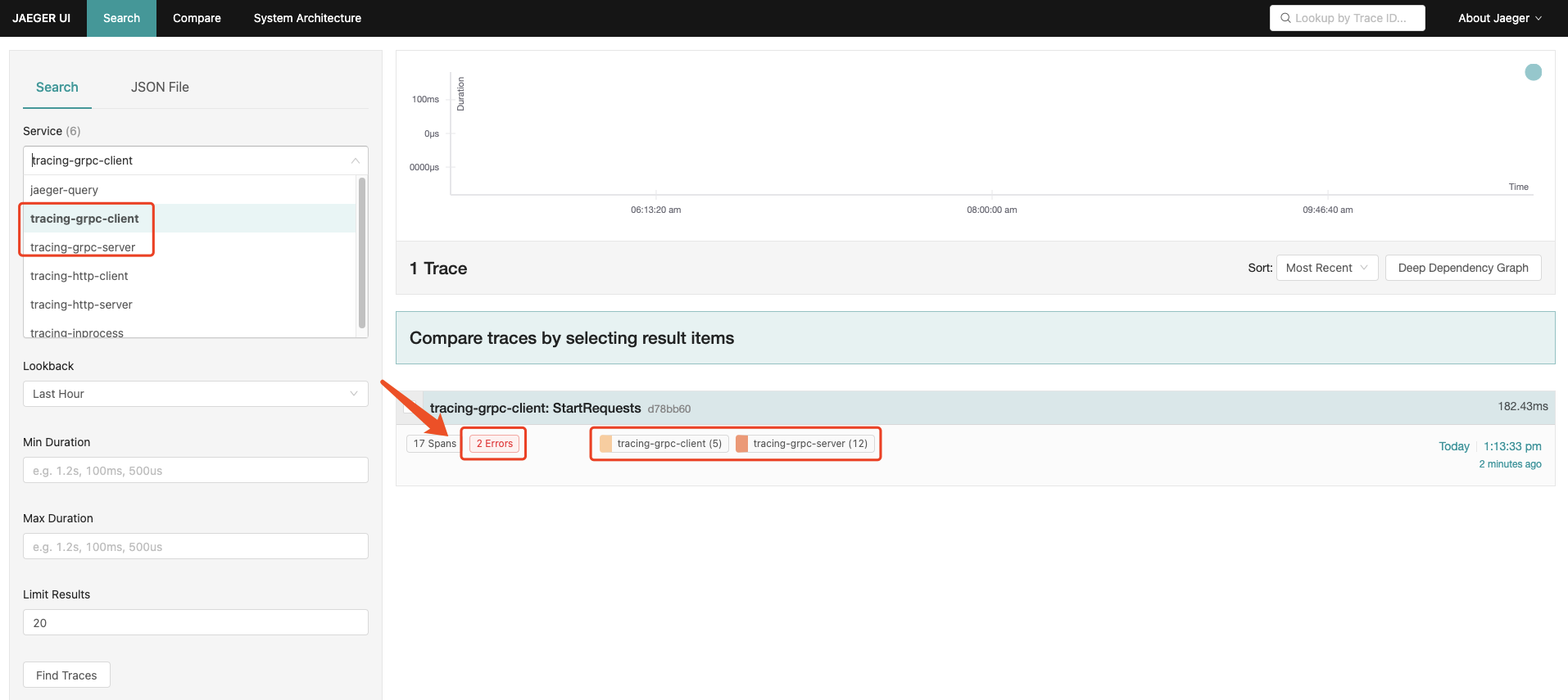
You can see that this request involves two services: tracing-grpc-client and tracing-grpc-server, which are the client and the server. The entire request link involves 17 spans, with the client having 5 spans, the server having 12 spans, and producing 2 errors. Let's click to view the details:

Let's click to check the span situation of the last interface call error:

It looks like a parameter validation error, click to view the request parameters in Events/Logs:
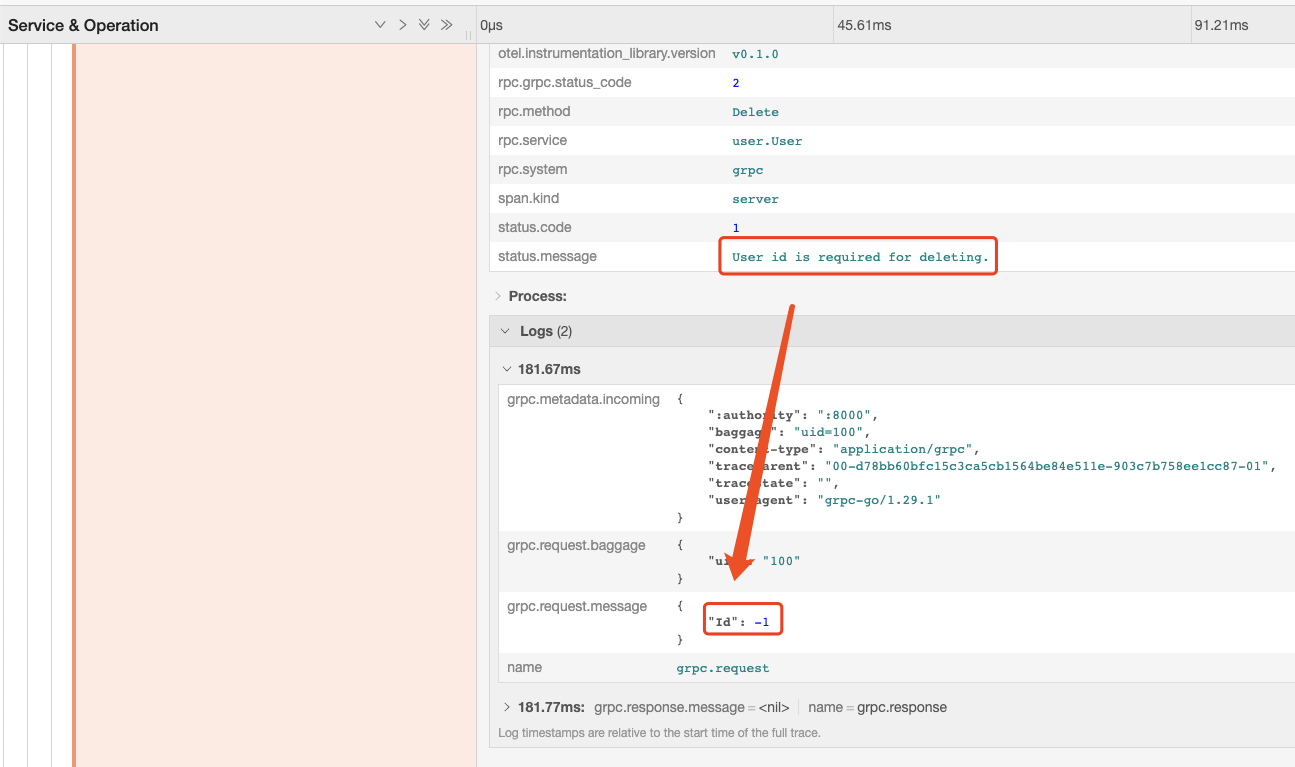
Checking the Log information in Process, it can be seen that the error occurred because the parameter passed was -1, which did not meet the validation rules, hence an error was returned during data validation.
GRPC Client
Since orm, redis, and logging components have previously introduced link information, here we mainly introduce link information for GRPC Client&Server.
Attributes
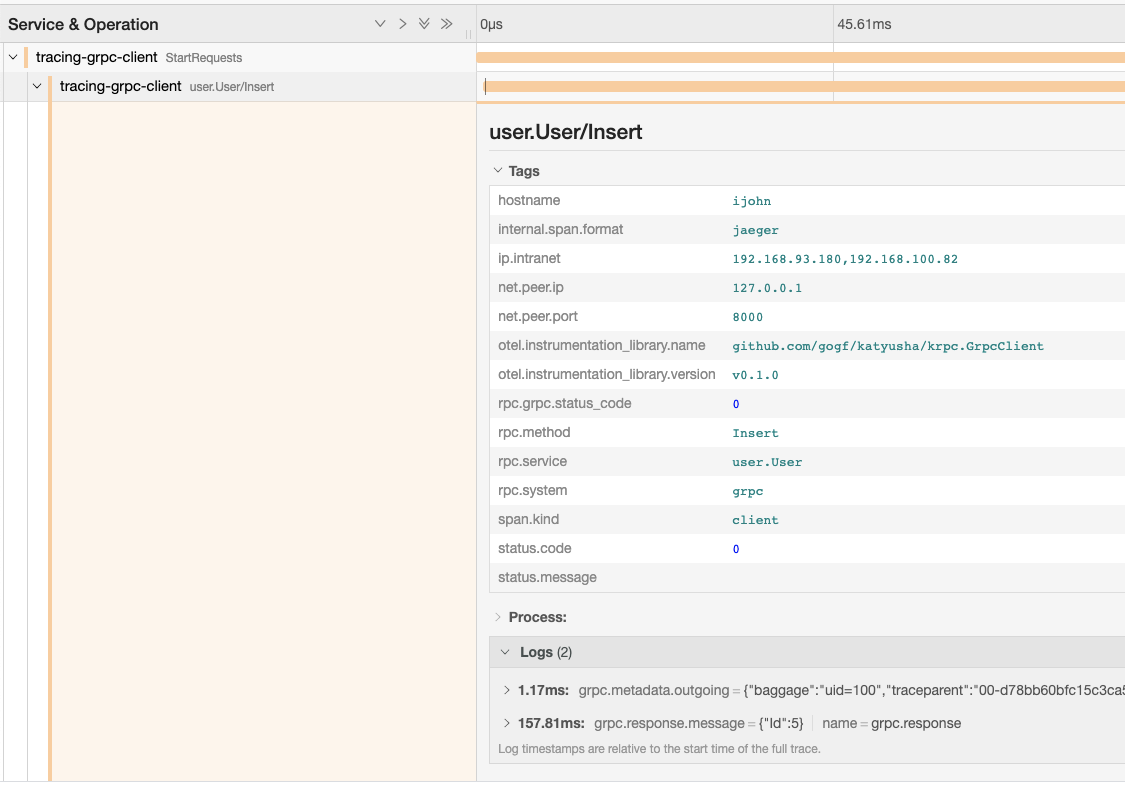
| Attribute/Tag | Description |
|---|---|
net.peer.ip | Target IP of the request. |
net.peer.port | Target port of the request. |
rpc.grpc.status_code | Internal status code for GRPC, 0 indicates success, non-0 indicates failure. |
rpc.service | Name of the RPC service, note that this is RPC not GRPC, as this is a general definition, and the client supports multiple RPC communication protocols, with GRPC being one of them. |
rpc.method | Name of the RPC method. |
rpc.system | Type of RPC protocol, such as: grpc, thrift, etc. |
Events/Logs
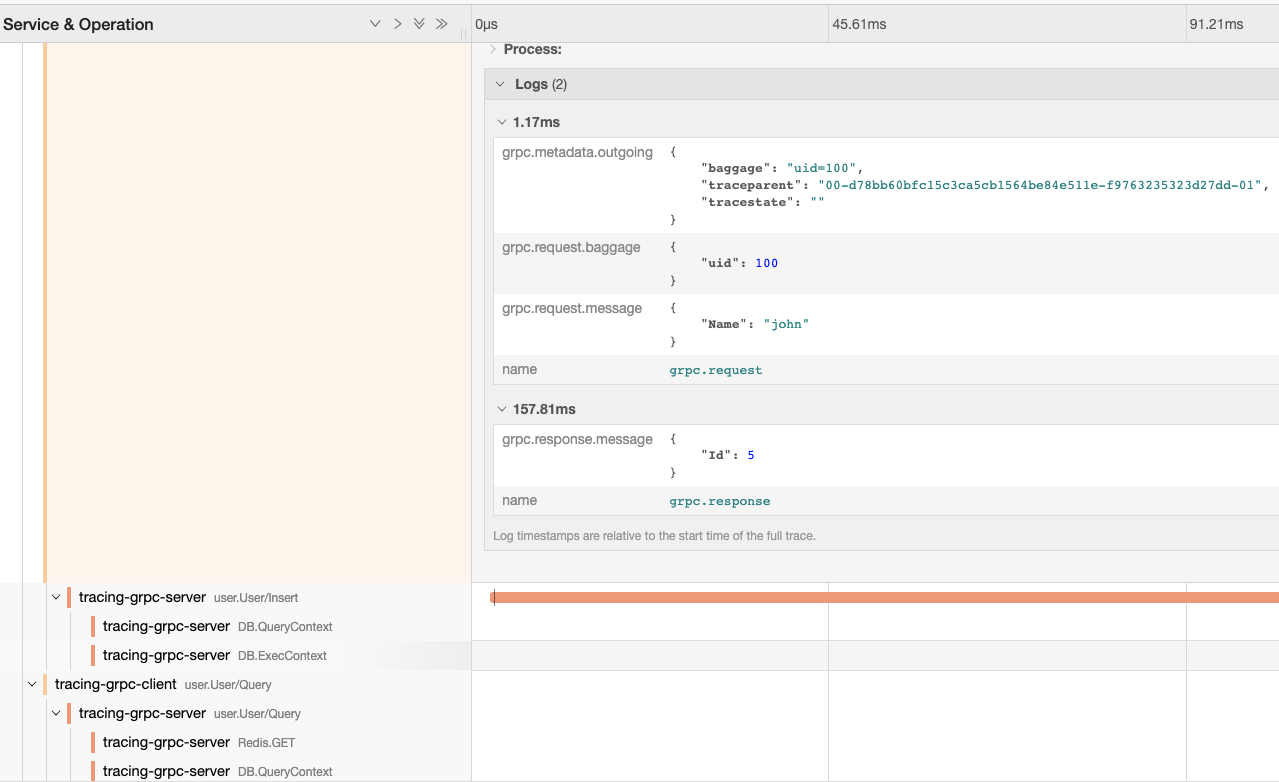
| Event/Log | Description |
|---|---|
grpc.metadata.outgoing | GRPC client request submitted Metadata information, which may be large. |
grpc.request.baggage | GRPC client request submitted Baggage information for service-to-service trace information transmission. |
grpc.request.message | GRPC client request submitted Message data, which may be large, only 512KB is recorded, and if it exceeds that size, it is ignored. Only valid for Unary request types. |
grpc.response.message | GRPC client request received returned Message information, which may be large. Only valid for Unary request types. |
GRPC Server
Attributes
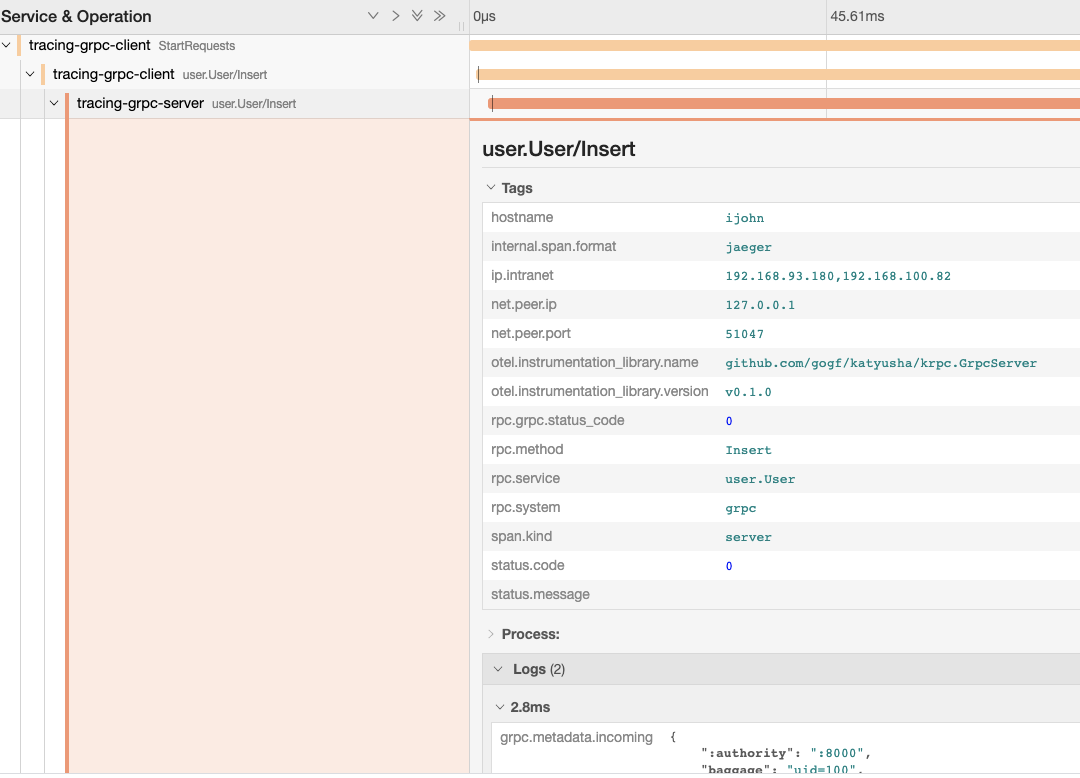
GRPC Server attributes mean the same as GRPC Client, with parsed data being almost identical in the same request.
Events
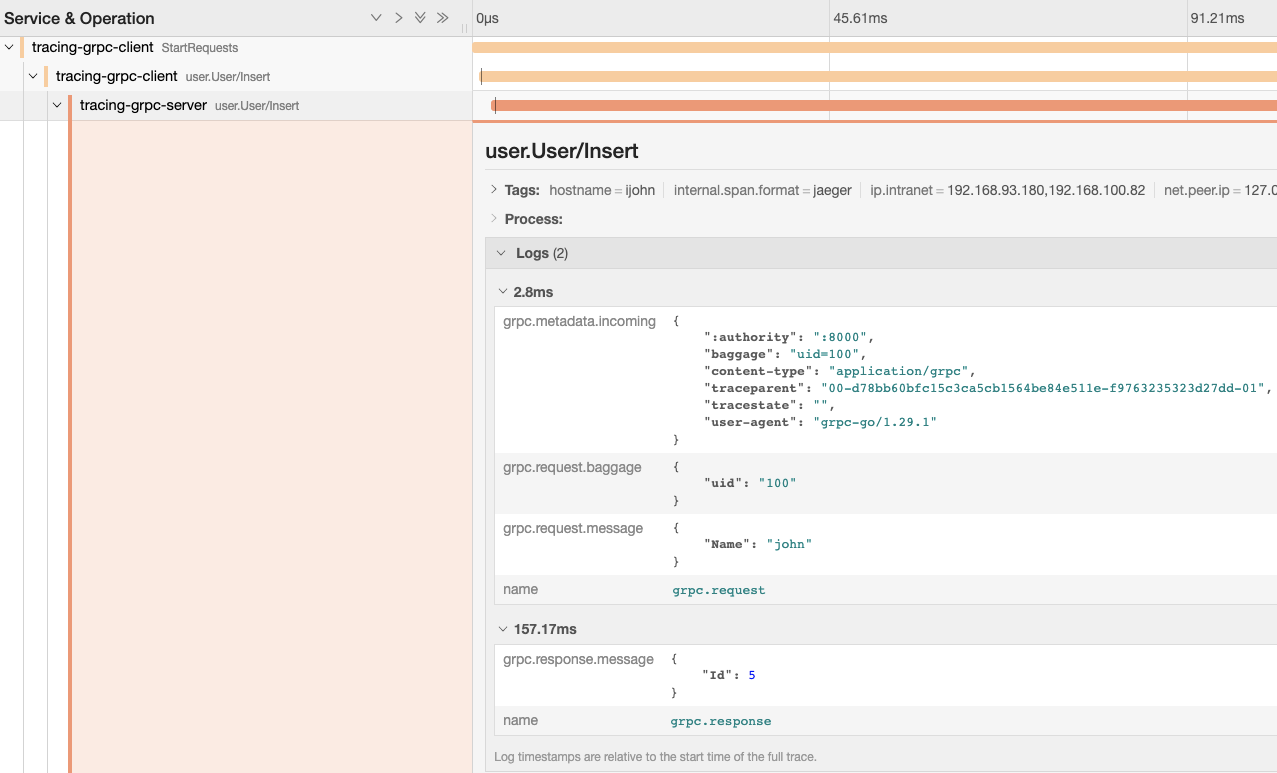
The difference in Events for the GRPC Server compared to the GRPC Client is that in the same request, the metadata received by the server is grpc.metadata.incoming, while others are the same as the GRPC Client.